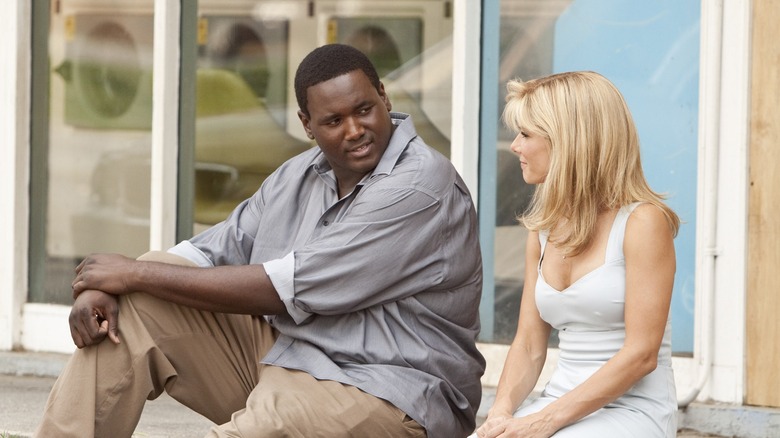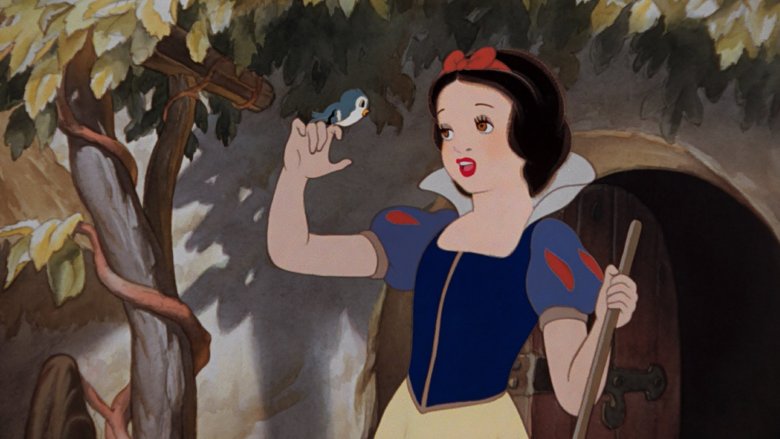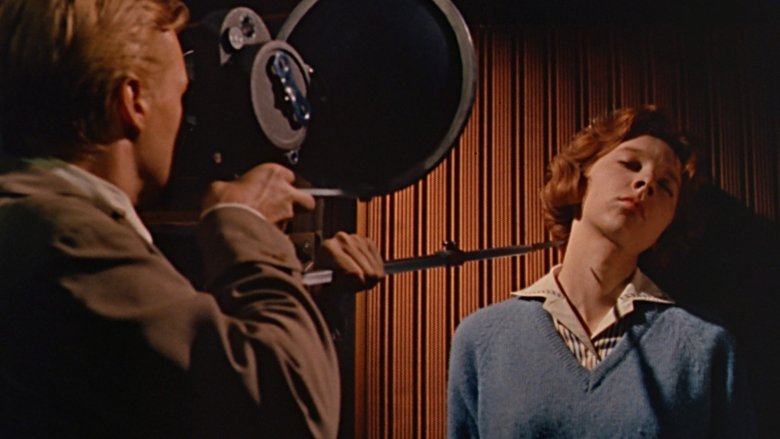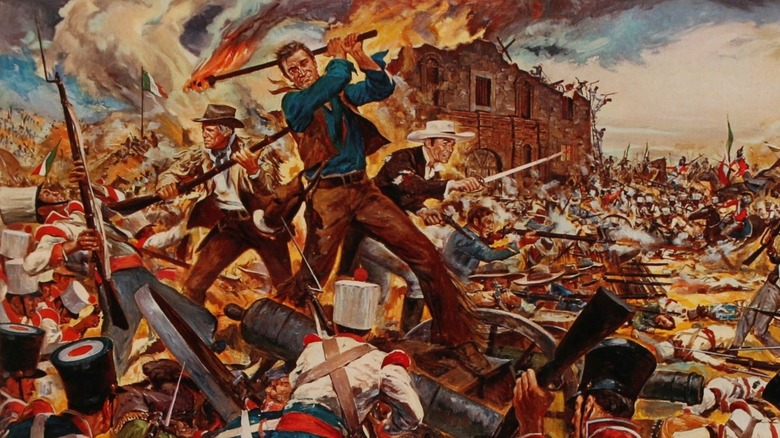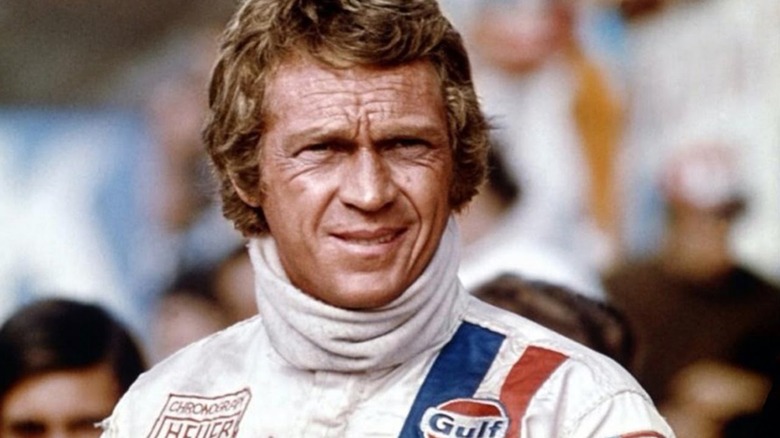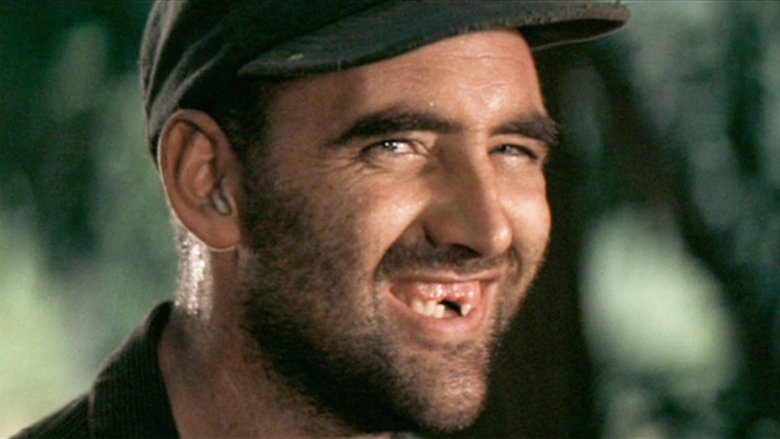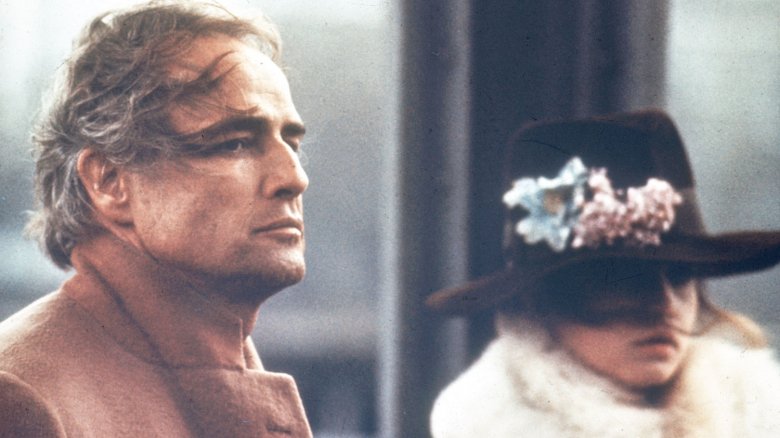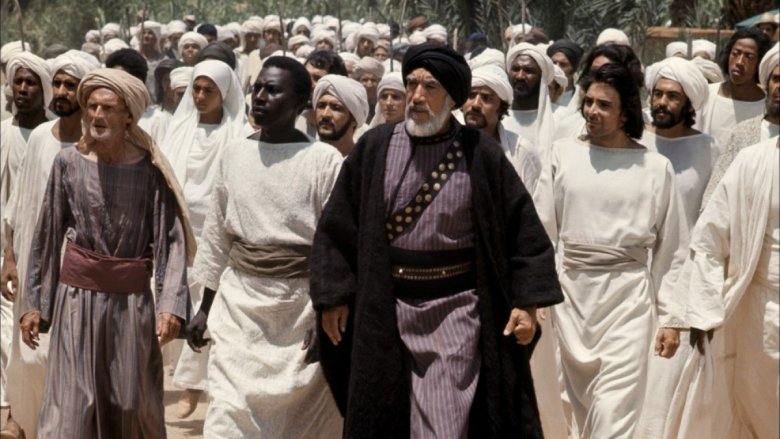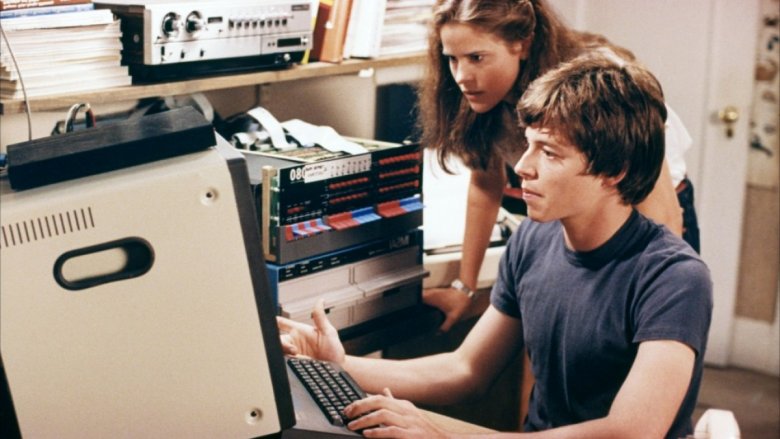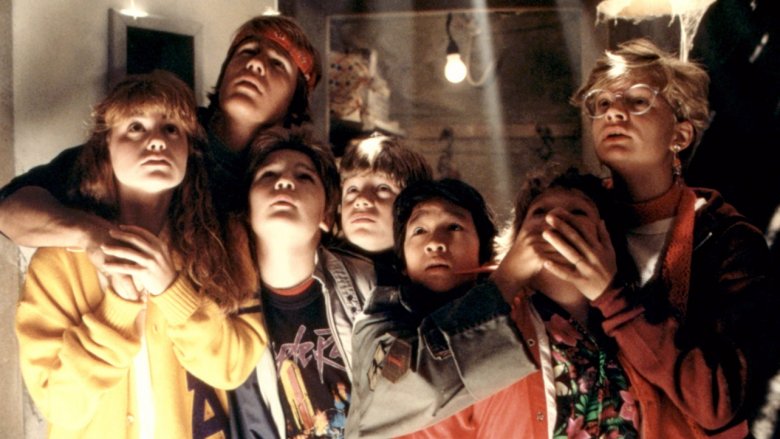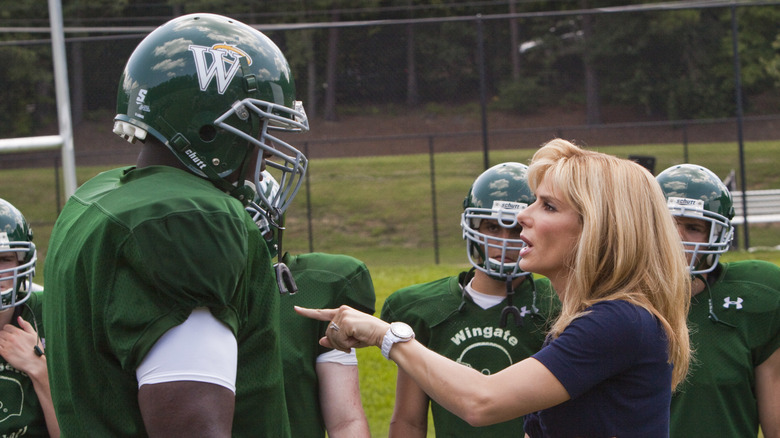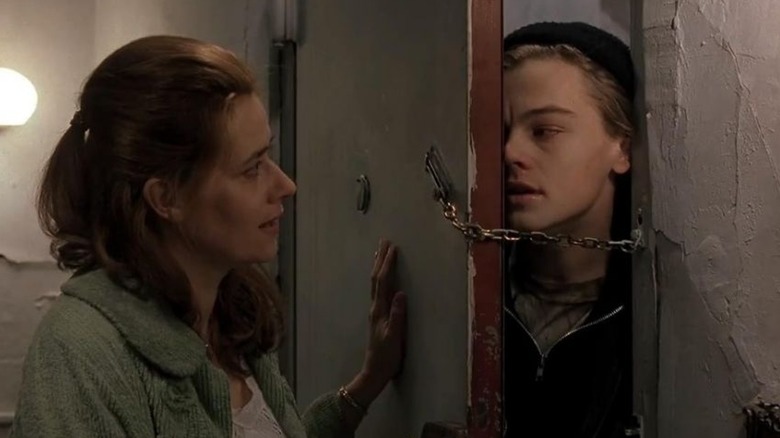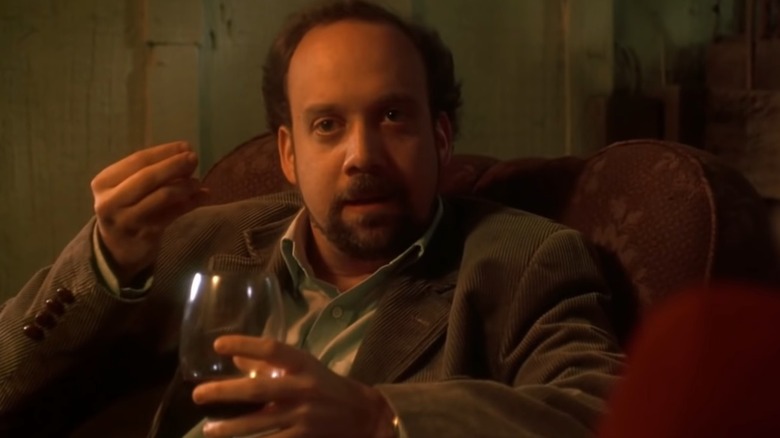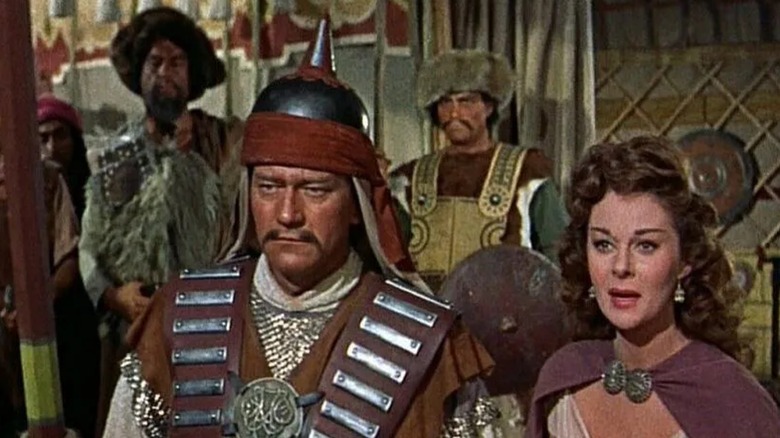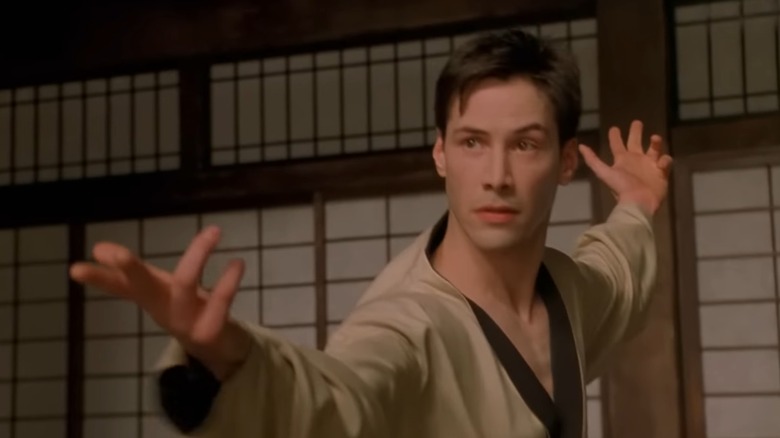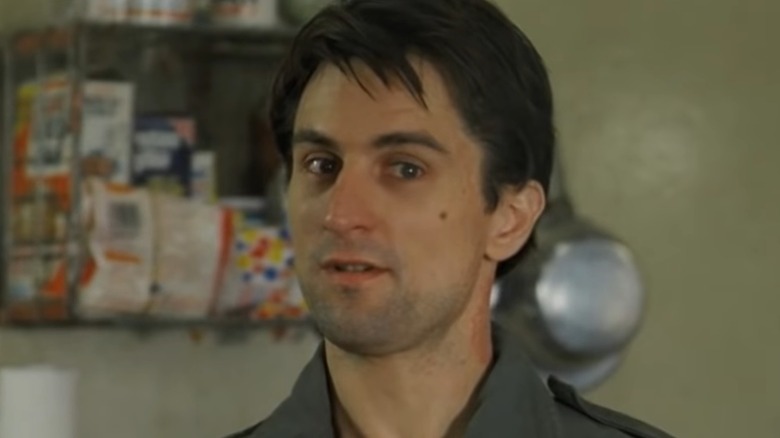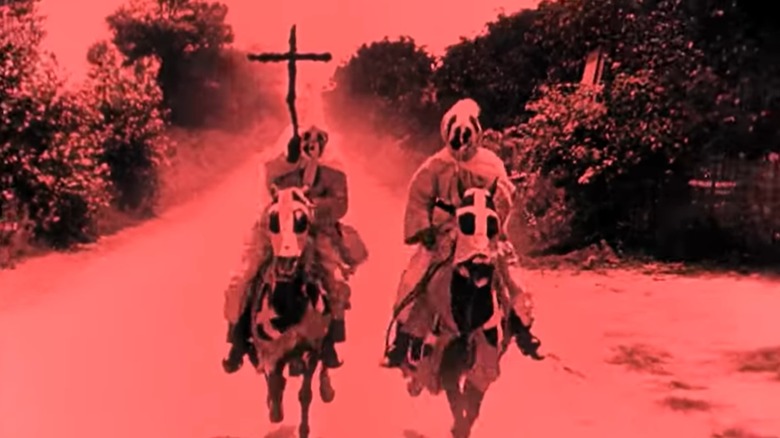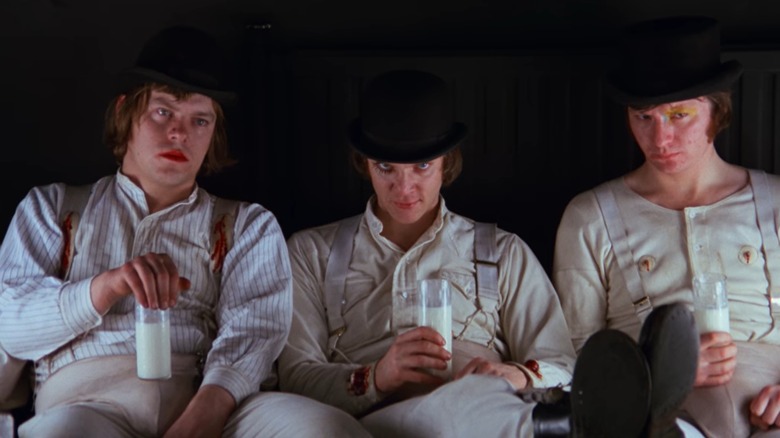Movies That Ruined People's Lives
The following article includes references to suicide, drug addiction, sexual assault, and racial violence.
Movies serve a multitude of purposes, from providing escapist entertainment to shining a spotlight on important issues. They are supposed to make us laugh, scream, cry, and think, but generally speaking, they're not supposed to ruin our lives.
Unfortunately, every so often a film will come along that just completely screws someone over. Maybe it ruins a filmmaker's career, or perhaps it embarrasses someone involved with the production. In some extreme cases, movies have been involved in murder plots, suicide attempts, and terrorist attacks. Sadly for the people on this list, their lives were touched by the power of the cinema, and things didn't end well for those involved.
Snow White and the Seven Dwarfs
As it was the first animated feature-length film ever made, you'd think "Snow White and the Seven Dwarfs" would've turned its leading lady, Adriana Caselotti, into a major star. After all, the film was a big hit and a cinematic landmark. But despite playing in one of the most beloved movies ever made, Caselotti largely vanished from the Tinseltown scene after working on the Disney film. True, you can briefly hear her voice in both "The Wizard of Oz" and "It's a Wonderful Life," but aside from those few roles, she never got much work in the movie business. Most people blame the film that got her started in the first place.
Some conspiracy theories claim that Walt Disney refused to let Caselotti work anywhere ever again, keeping her under a tight contract so she couldn't use her iconic voice in any other film. However, Disney didn't start contracting actors until 1946, so that theory is unlikely. Instead, it's possible that Caselotti's own talent betrayed her. If you've seen "Snow White," you'll know the actress has one of the most recognizable voices in Disney history, and it's said the titular movie mogul wouldn't cast her again because her voice was just too easy to identify. Sadly, it seems the rest of Hollywood felt the same way, and other movie studios — especially those involved with animation — didn't want audiences saying, "That character sounds like Snow White!"
On the flip side, Disney did use her multiple times over the years to promote "Snow White." Whenever the company planned to re-release the film, Caselotti was hired for publicity tours. And in 1994, she was given the honor of becoming a Disney Legend. Still, if Caselotti could do it all over again, you've got to wonder if she'd choose a steady career over one great film.
Peeping Tom
Once upon a time, Michael Powell was one of the most beloved filmmakers in Great Britain. With his frequent collaborator Emeric Pressburger, the director created some of the greatest films of English cinema, such as "Black Narcissus" and "The Red Shoes." But everything changed in 1960 when Powell directed "Peeping Tom," a wild departure from his previous work. Similar to Alfred Hitchcock's "Psycho" (which came out the same year), "Peeping Tom" focuses on a shy, sexually repressed young man who gets his kicks by murdering women. Only instead of stabbing them in the shower, this guy films their deaths while murdering them with a blade attached to his camera tripod.
While it's tame by today's standards (but still pretty disturbing), audiences at the time were absolutely shocked. "Peeping Tom" deals with all kinds of uncomfortable topics, including child abuse and pornography. As a result, British critics lost their minds, labeling the film as "perverted" and "beastly." One critic wrote it was "the sickest and filthiest film I remember seeing," and another wrote the movie should be "flushed swiftly down the nearest sewer." That's pretty much what happened, too. According to Powell himself, the film's British distribution was canceled, and the producers sold the negative.
After "Peeping Tom," Powell was basically exiled from the British film industry and forced to make movies in other countries, none of which lived up to his old classics. As a result, the man and his movie faded into obscurity until 1979, when Martin Scorsese re-released the film, kickstarting a newfound appreciation for the early serial killer flick. These days, "Peeping Tom" is considered one of Powell's best films. Roger Ebert added it to his list of "Great Movies," and the British Film Institute labeled it the 78th greatest British film ever. Still, there's no denying this 1960 flick completely killed Powell's career.
The Alamo
Released in 1960, "The Alamo" was a passion project for John Wayne, marking the movie star's directorial debut. Unfortunately, the production was beset with all sorts of problems. One of the lead actors broke his foot, a flood wiped out the set, and about 80% of the crew came down with a nasty bug. But in between dealing with out-of-control fires and automobile accidents, the cast and crew of "The Alamo" found themselves in the middle of a murder investigation.
It all started when a group of actors known as the Hollywood Starlight Players auditioned for the film. They were all cast as extras except for one actress named Lagene Ethridge. She was given a much larger role, complete with actual lines, and as a result, she got to live closer to the set. However, this didn't sit well with her actor boyfriend, Chester Harvey Smith, who had to get a room in a town 20 miles away. Angry about the living arrangements, Smith demanded that Ethridge move into town with him, and when she refused, Smith responded like a mature adult by stabbing her to death with a 12-inch knife.
Smith was quickly arrested, and the Duke later said he thought Smith should receive the death penalty. Instead, the actor was sentenced to 20 years behind bars.
Le Mans
Coming off hit films like "Bullitt" and "The Thomas Crown Affair," Steve McQueen hoped to do something a little different with his next project. He wanted to make the greatest racing movie ever. McQueen's plan was to star in a documentary-style film about the 24 Heures du Mans, an event where drivers compete for 24 hours straight. The King of Cool thought it would be the perfect subject for his new movie.
Unfortunately, things didn't pan out the way McQueen hoped. The film's original director, John Sturges ("The Magnificent Seven," "The Great Escape"), wanted to make a more conventional narrative film, and the two clashed so hard that Sturges eventually left the project. Soon, the movie had gone so far over budget that McQueen was forced to give up his salary, any future profits, and control of the picture if he wanted to finish the film. Worse still, the making of "Le Mans" ultimately caused his company, Solar Productions, to collapse.
But at the end of the day, at least McQueen made it out of "Le Mans" in one piece. The same can't be said for David Piper. A Formula One racer working on the film, Piper was driving a Porsche 917 for a scene when one of the tires deflated. Piper lost control of the car, and in the ensuing accident, the driver majorly injured his leg. Sadly, the wound became infected, and the doctors were forced to amputate the lower part. The injury effectively ended his racing career, and it was all for a movie that's largely been forgotten by most moviegoers.
Deliverance
Based on the novel by James Dickey, "Deliverance" is a powerful story about how people react when they're ripped from civilization and thrust into a world without law or order. Unfortunately, most people remember it as the movie where Ned Beatty gets sexually assaulted by a hillbilly. Granted, it is the most memorable moment in a film full of toothless woodsmen and decrepit rednecks. In other words, it's easy to understand why the folks of Rabun County have mixed feelings about this film.
Rabun County, if you don't know, is where "Deliverance" was filmed, and believe it or not, the movie did wonders for the local economy, inspiring quite a few people to try white-water rafting. As a result, adventurers have been flocking to Rabun County ever since, and according to a 2012 CNN article, tourists bring over $40 million to the area each year. However, while the money is nice, not everyone is happy with the way Southerners are depicted in the film. Speaking with CNN, one Rabun County resident said, "There are still a lot of people here locally who have hard feelings about the stereotypes the movie represented."
As a county commissioner put it, "We were portrayed as ignorant, backward, scary, deviant, redneck hillbillies." But this goes a whole lot further than just hurt feelings. According to a report by Marketplace, people have claimed they were "passed up for jobs because they came from Rabun County." And when locals planned on celebrating the film's 40th anniversary, quite a few citizens complained.
Last Tango in Paris
One of the most controversial movies ever made, Bernardo Bertolucci's "Last Tango in Paris" starred Marlon Brando as an American widower who gets involved with a young French woman played by Maria Schneider. Their relationship is purely sexual, and things quickly spin out of control. After working on the film, Schneider claimed that she couldn't deal with her newfound fame, and soon, she was using cocaine and heroin as "an escape from reality" according to the Los Angeles Times. Schneider eventually hit such a rough patch that she attempted suicide.
However, in recent years, it's become apparent that Schneider was probably suffering from more than just unwanted media attention. In 2016, a three-year-old interview with Bertolucci came to light, and it included a segment where the director elaborated on the movie's most infamous scene — a moment where Brando's character rapes Schneider's character while using butter as lubricant. True, the attack was in the script (and the on-screen sex is simulated), but the use of butter wasn't in the screenplay. As Bertolucci explained in the 2013 interview, this was an impromptu decision that he and Brando made on-set, and they deliberately didn't tell Schneider what they were going to do.
According to Bertolucci, he didn't inform the 19-year-old Schneider because he "wanted her reaction as a girl, not as an actress. I wanted her to react humiliated" (via The Washington Post). Schneider commented on the scene in an interview with The Daily Mail in 2007, saying she was "crying real tears" and that she "felt a little raped, both by Marlon and by Bertolucci." After Bertolucci's confession, many have posited that Schneider's behavior after "Last Tango" had more to do with PTSD than her sudden celebrity. In her 2007 interview, given a few years before her death from cancer, the actress admitted that if she had to choose again, she would've passed on the film.
The Message
In 1977, director Moustapha Akkad released "The Message," a desert epic in the vein of "Lawrence of Arabia." Only instead of focusing on an English adventurer, the film tells the story of the Prophet Muhammad and the rise of Islam. True, you're not supposed to actually depict Muhammad, but Akkad got around this by having actors speak directly at the audience, as if the camera itself was the prophet. But despite Akkad's attempts at making a peaceful, inoffensive film, quite a few people took his message the wrong way.
Multiple countries banned the film, but even worse, one man decided to stage a protest — with swords and shotguns. On March 9, 1977, Hamaas Abdul Khaalis and 11 of others drove to Washington D.C. and took over multiple buildings around the city. Armed with firearms and all sorts of blades, Khaalis took 149 hostages and made two demands. First, he wanted the government to release a group of prisoners who'd murdered his family years before (It seems he wanted to serve his own brand of bloody justice). Second, he demanded that "The Message" be removed from theaters.
As a result, several New York theaters put their screenings on hold, although the government declined to follow up on Khaalis' first demand. Tragically, this attack wasn't without casualties. When the group stormed the District Building, since renamed the Wilson Building, Khaalis and his group shot and murdered a security guard named Mack Cantrell and a reporter named Maurice Williams. Fortunately, the rest of the hostages were freed 39 hours later, per The Atlantic, and Khaalis was sentenced to life in prison, where he died in 2003. As for filmmaker Moustapha Akkad, he went on to have success as a producer, helping create one of the greatest horror franchises of all time: the Halloween series.
WarGames
A genius and online activist who helped create RSS, Reddit, and Creative Commons, Aaron Swartz thought it was wrong to charge astronomic fees for scientific research and scholarly works. Wanting to make a point, Swartz hacked into the digital library JSTOR and illegally downloaded quite a few articles. But this stunt didn't sit well with the feds, and soon, Swartz found himself facing 35 years behind bars. As a result, the internet pioneer ended his own life at the age of 26.
So what does this have to do with the movies? Well, the law used to prosecute Swartz was directly connected to the 1983 hit "WarGames." This Matthew Broderick movie follows a young computer whiz who hacks into NORAD and (accidentally) almost starts World War III. Evidently, the movie freaked out the folks in Washington, D.C., with one congressional report claiming "WarGames" was a "realistic representation" of what hackers could do (per CNET). Four minutes of the movie were even shown in Congress as a kind of warning about the dangers of the internet.
While it wasn't the only factor, "WarGames" played a very real part in inspiring the Computer Fraud and Abuse Act (CFAA) of 1984. Originally, the law was meant to prosecute people who attacked banks or agencies related to America's defense system. But over the years, the law was amended so many times that it could be used to prosecute hackers who steal government secrets, as well as hackers who download scholarly articles, which is probably not how Matthew Broderick wanted audiences to respond to his film.
The Goonies
Depending on who you ask, "The Goonies" is either one of the all-time great adventure films or one of the most annoying movies ever made. But despite the haters, the people who love this movie really love it. In fact, fans from as far away as Europe have made the pilgrimage to Astoria, Oregon just to see "Goonies" house for themselves. You know the one. It's two stories tall, has torture devices in the attic, and you have to do the truffle shuffle to get inside.
But while the Astoria house has brought joy to a lot of fans, not everyone is so happy with the home's prominent place in movie lore — namely, the owner. Sandi Preston bought the house in 2001, and at first, she was totally cool with fans showing up to take photos. Sometimes she even let people inside and gave tours. However, that all changed in 2015 when she wrapped her house with blue tarps and set out hand-written signs saying her home was now off-limits to the public.
So what prompted such a radical change? Well, "The Goonies" was kind of ruining her life. In more recent years, the number of tourists coming to see the house was on the rise. Shockingly, during the summer of 2015, up to 1,500 people dropped by her home every single day, according to NBC News. And while some were on their best behavior, many of these fans didn't care all that much about manners. They'd park on the sidewalk, leave beer bottles everywhere, and let their dogs do their business wherever they pleased. Eventually, it was just all too much for Preston, who decided it was time to take her house back. But as of 2023, the house had been sold to a "Goonies" superfan with plans of restoring it as a cinematic landmark.
The Blind Side
If a filmmaker ever asks to make a movie about your life, you might want to think twice before saying yes. There have been quite a few biopics in recent years that have left their subjects feeling rather unhappy. For example, Patch Adams hated that 1998 Robin Williams movie, feeling it reduced him to being just a "funny doctor" (per Renaissance Universal). Olympic wrestler Mark Schultz was incredibly upset with "Foxcatcher" director Bennett Miller. And former NFL player Michael Oher has claimed that "The Blind Side" severely impaired his professional career.
If you've never seen the film, Oher (played by Quinton Aaron) is portrayed as a troubled teen who finds new direction in life when he meets Leigh Anne Tuohy, a wealthy mom played by Sandra Bullock. Over the course of the film, Tuohy inspires Oher to play football and go to college. As a result, he joins the NFL, playing for the Baltimore Ravens. But while the movie earned more than $300 million and snagged Bullock an Oscar, it didn't do Oher any favors.
Speaking to ESPN in 2015, Oher claimed that the movie put a lot of undue pressure on his career. "People look at me," he explained, "and they take things away from me because of a movie. They don't really see the skills and the kind of player I am." A year later, Oher elaborated on his feelings to SB Nation, saying, "There was a time in my life early in my NFL career where the movie just seemed to take away from me. It made it seem like the movie was responsible for my NFL career, not my play, not my hard work." Things only became more complicated in 2023 when Oher sued the Tuohy family, revealing that they had never actually adopted him and claiming that a conservatorship they had tricked him into was used to financially manipulate him.
The Basketball Diaries
Even early in his career, Leonardo DiCaprio always preferred lending his talents to movies with dark subject matter. Sometimes, this resulted in critical acclaim, while other times, it led to lackluster movies like "The Basketball Diaries," a Hollywood dramatization of the autobiography of celebrated author and poet Jim Carroll.
The movie follows Jim (DiCaprio) as a teenager in high school struggling with drug addiction, which leads him to slowly isolate himself from everything and everyone he cares about until he finally gets clean after a six-month stint in prison. The movie ended up garnering mixed reviews and an unimpressive box office return. And, normally, a film like this would have long left the zeitgeist more than 25 years after its release.
However, the movie later became entangled in an unimaginable tragedy at Heath High School in West Paducah, Kentucky. On December 1, 1997, Michael Carneal entered the school premises with four concealed firearms and proceeded to fire 11 shots in the school lobby. This tragically led to three students losing their lives and five more being injured. Carneal later claimed to have been inspired by a dream sequence in "The Basketball Diaries" where Jim dreamed of shooting his class (per History). This led to a lawsuit against the movie's distributors that ultimately got dismissed.
Sideways
"Sideways" tells the story of Miles Raymond (Paul Giamatti), a teacher who feels he hasn't lived up to his potential. He's divorced, lacks confidence, and hopes that a trip to Santa Ynez Valley wine country with his best friend, Jack Cole (Thomas Haden Church), will help him regain his mojo. During the trip, he meets Maya (Virginia Madsen), and they share a deep connection due to their mutual interest in wine.
Throughout the movie, Miles struggles with the news that his ex-wife has remarried since their breakup. In an attempt to detach himself from that relationship, he humorously vows never to drink merlot again, as it was his ex-wife's favorite wine. Instead, he prefers Pinot Noir, a preference he shares with Maya. There's a scene where he passionately describes Pinot Noir, and within the context of the movie, Pinot Noir serves as a metaphor for Miles' character arc — difficult to cultivate but incredibly rewarding with time and effort.
However, due to the influential nature of movie magic, the majority of mainstream audiences misinterpreted this aspect of the film and only took away the message that Merlot is bad wine and Pinot Noir is great wine. This misconception led to significant repercussions in the wine industry, with a drastic drop in Merlot consumption. The phenomenon became known as the "Sideways Effect" and has even become a subject of university research.
The Conqueror
"The Conqueror," a 1956 film, is notorious for being associated with one of the biggest on-set tragedies in Hollywood history. The movie is poorly regarded among film fans and considered a run-of-the-mill "origin story" for Genghis Khan, with John Wayne woefully miscast in the lead role. The plot revolves around Khan kidnapping Bortai (Susan Hayward), a royal of the Tatars, which leads to war. Despite his lack of leadership skills, Khan ultimately wins both the war and the girl. The film received dismal reviews from critics, even in its day.
However, the movie's quality isn't even the most significant tragedy associated with it. The Atomic Energy Commission (AEC) had assured the film's producers that the shooting location in the Utah desert was safe. Unfortunately, the area was located less than 140 miles downwind from a major Nevada desert nuclear test site. Almost half of the 220 cast and crew members involved in the film developed some form of cancer later in life, according to a 1980 report from People. At that time, 46 people who worked on the film had died from the disease, which was likely connected in some part to their participation in the production.
The film's dismal reception and the controversy surrounding its production became a major plot point in Martin Scorsese's film "The Aviator," in which Leonardo DiCaprio portrays producer Howard Hughes. The movie was so poorly received that Hughes reportedly attempted to purchase every copy of it and became obsessed with watching it daily as he struggled with declining mental health later in life.
The Matrix
"The Matrix" is a film with many meanings and interpretations. The Wachowskis have said that they originally envisioned the film as a trans allegory, with an early script even featuring characters having different genders in the virtual world and the real world. It's also a story about the dangers of technology and what it truly means to be human. However, the film's complexity also laid the groundwork for some severe misinterpretations.
One particularly troubling impact of "The Matrix" is how some individuals started using its premise of humans living in a computer-generated world to justify their crimes. This legal defense strategy became known as the "Matrix defense." The first known use of this defense came in 2000 when Swiss exchange student Vadim Mieseges killed and mutilated his landlady in San Francisco. According to the Boston Globe, Mieseges cited "evil vibes" as his reasoning and said he was scared of getting "sucked into the Matrix." He was subsequently ruled insane. There have been several other cases attempting to use the same defense, including that of murderer Lee Malvo, the so-called "D.C. Sniper."
In a later report, CNN noted that this defense strategy is no longer as reliable, and a defendant attempting to use it would likely lose their case in the present day. Lilly Wachowski, one of the film's creators, has become increasingly frustrated with people misinterpreting the movie and has been seen on social media criticizing posts that use "The Matrix" to justify hateful or harmful ideas.
Taxi Driver
"Watching films came out of a necessity from the illness of asthma," Martin Scorsese said in a 2023 GQ profile. "And it came out of a loneliness, which I still have, which had to do with my father and my mother." Perhaps this sense of loneliness played a role when he directed one of the most brutal portrayals of loneliness in the history of cinema — "Taxi Driver."
"Taxi Driver" is a must-see for movie enthusiasts. It follows the story of Travis Bickle (Robert De Niro), a New York City cabbie who gradually loses touch with reality and resorts to extreme violence, leading to a bloody climax. "Taxi Driver" quickly became a hit, earning a great box office return for its budget and receiving numerous accolades, including an Oscar nod for a young Jodie Foster for best supporting actress.
As chronicled by The Independent, the film's success led to John Hinckley Jr. becoming obsessed with Foster. He repeatedly approached her and stalked her, and, when she politely rejected his advances, he felt compelled to find a way to impress her. Hinckley Jr. had reportedly watched "Taxi Driver" over a dozen times and was inspired by a scene in which Bickle tries to shoot a politician. Consequently, Hinckley Jr. attempted to assassinate President Ronald Reagan, firing a bullet that narrowly missed his heart. He was subsequently placed under psychiatric confinement.
The Birth of a Nation
"The Birth of a Nation" undeniably stands as one of the most racist films of all time — a heinous distinction that's likely to persist indefinitely into future. The movie chronicles a post-Civil War America in which Confederate colonel Ben Cameron (Henry B. Walthall) establishes the Ku Klux Klan and terrorizes Black Americans in the South, all while being positioned as a hero by the script.
The film is often credited with pioneering cinematic techniques that continue to be used in filmmaking today, such as close-ups. However, fixating solely on the film's technical prowess obscures the fact that it played a significant role in revitalizing the Ku Klux Klan. Its glorification of lynchings and cross-burnings quickly turned the film into a recruitment tool for the Klan, making its legacy truly evil.
When the film was initially released, the NAACP rightly raised objections about its extensive use of blackface and the despicable portrayal of Black people. However, these objections did not prevent the movie from becoming one of the most commercially successful films of all time. A Harvard University study even revealed that the film's initial roadshow release led to an increase in lynchings by up to five times in areas where it was screened. This grim reality solidifies "The Birth of a Nation" as one of the most harmful movies ever made.
A Clockwork Orange
Stanley Kubrick, one of the most revered directors of all time, is best known for his exploration of the darker aspects of human nature — particularly violence. Of all his films, none delves into violence quite like "A Clockwork Orange." The movie follows Alex DeLarge (Malcolm McDowell), a violent gang leader in a near-future Britain who dons a white costume and bowler hat, spending his days assaulting the unhoused and terrorizing people in home invasions with his gang.
The film's underlying message is that human beings have not entirely evolved beyond such violent and aggressive tendencies; we've merely hidden those behaviors beneath a facade of civilization. However, at the time of its release, some critics argued that the movie ended up glorifying violence. "A Clockwork Orange" stirred so much controversy that Kubrick himself asked Warner Bros. to withdraw the film from cinemas due to reports of copycat violent attacks inspired by the movie.
One of the most notorious individuals influenced by the film was Peter Foster, a British fairground worker who became obsessed with it. Foster often dressed like Alex DeLarge and subjected multiple partners to violent abuse over the course of three decades, murdering two women. He was ultimately convicted and handed multiple life sentences in prison.
If you or anyone you know is struggling or in crisis, needs help with addiction issues, has been a victim of sexual assault, or has experienced a hate crime, contact the relevant resources below:
-
The Suicide & Crisis Lifeline – call or text 988 or chat 988lifeline.org
-
The Substance Abuse and Mental Health Services Administration website or SAMHSA's National Helpline at 1-800-662-HELP (4357).
-
The Rape, Abuse & Incest National Network website or RAINN's National Helpline at 1-800-656-HOPE (4673).
-
The VictimConnect Hotline by phone at 1-855-4-VICTIM or by chat
